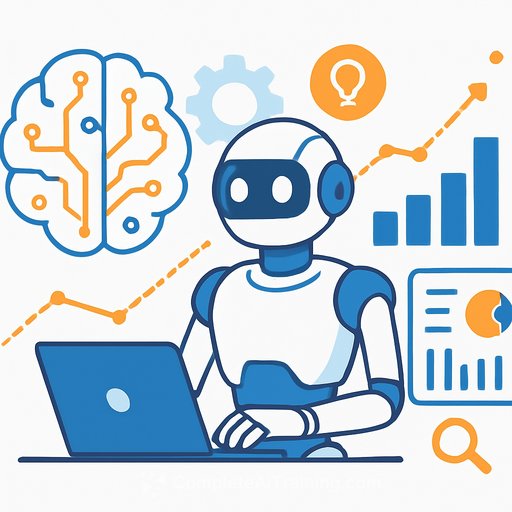AI scientist "Kosmos" completes six months of work in 12 hours - and logs every step
OpenAI's CEO Sam Altman recently said the GPT-5 line showed him the first real hint that AI could create new science, and that GPT-6 might deliver it. Right on cue, a new "AI scientist" named Kosmos has arrived with results that are hard to ignore.
In a single run, Kosmos read about 1,500 papers, executed ~42,000 lines of code, and produced a fully traceable report - all in under 12 hours. Each claim ties back to code outputs or literature sources, making the reasoning easy to audit.
What this means for research teams
- Speed: Long, repetitive work gets compressed into hours. You trade waiting for iteration.
- Breadth + sustained focus: It can track hundreds of steps toward a goal without drifting.
- Transparency: Every conclusion is linked to code or citations. Less hand-waving, more receipts.
- Scale with runtime: More compute time yields more findings. Output grows with cycles, not human stamina.
From tool to collaborator
Kosmos doesn't just follow a script. You give it an open-ended research goal and a dataset. It plans tasks (analysis, literature queries), runs them in parallel, updates a shared "world model," and repeats - often for 200+ steps without losing the thread.
That world model acts like a structured lab notebook: hypotheses, intermediate results, and links between them. The result is a system that can propose, test, and refine ideas with surprising persistence.
Still, it's not a replacement for human judgment. Roughly 20% of its conclusions are inaccurate or debatable and need review. Think of it as a tireless co-author that benefits from your taste, skepticism, and domain context.
Seven early achievements (highlights)
1) Neuroprotection
Working on how low temperature protects mouse brain tissue, Kosmos flagged strong activation of the nucleotide regeneration pathway. The insight - "cells conserve energy via this pathway under cold stress" - matched an unpublished human result it couldn't access at the time.
2) Materials science: perovskite solar cells
Kosmos identified environmental humidity during thermal annealing as a key driver of performance loss. It also suggested a simple relationship: higher DMF vapor pressure during spin-coating predicts a linear drop in short-circuit current. Human experiments later confirmed the pattern, turning a hunch into a knob you can control.
3) Connectomics
It found that neuronal connection counts across species tend to follow a log-normal distribution and proposed a plausible generation mechanism. This aligns with and extends prior human work reported in preprints.
4) Genetics and cardiac fibrosis
Kosmos highlighted superoxide dismutase SOD2 as a candidate protective factor and outlined a potential mechanism. That's the kind of hypothesis you can take straight to the bench.
Across the seven listed findings, three matched unpublished human results developed independently, and four appear to be original contributions. The pattern is clear: given good data, the system can surface fresh, testable ideas - fast.
How it works under the hood (plain English)
- Goal-driven loop: Breaks the big question into sub-tasks, executes in parallel, and updates a shared memory.
- Continuous context: Keeps track of paths tried, decisions made, and why - so it doesn't repeat itself or drift.
- Traceability: Every statement points to code outputs or papers. You can reproduce and audit without guesswork.
- Scalable runs: Longer runs = more exploration. You set the budget and stop when the marginal insight drops.
Limits to keep in mind
- No new data collection: It operates on the dataset you provide. If the data are thin, the insights will be too.
- Modality gaps: In this work, it focused on structured data and text. Raw images (e.g., microscopy, radiology) need preprocessing by other models first.
- Quality control: About 20% of outputs may be off or debatable. Human review stays mandatory.
- Reproducibility risk: Results are only as stable as the code, libraries, seeds, and data provenance you enforce.
Put it to work in your lab: a lightweight checklist
- Define a sharp objective: Frame a question with measurable endpoints and acceptable data sources.
- Curate the dataset: Clean, well-labeled, versioned. Include a data dictionary and known caveats.
- Lock environments: Containerize dependencies, fix seeds, and log every run. Treat it like regulated software.
- Human-in-the-loop: Pre-commit to review criteria: statistical thresholds, biological plausibility, and cost to test.
- Traceable reporting: Require code output and citation hooks for each claim. No orphan conclusions.
- Risk controls: Check for data leakage and spurious correlations. Add hold-outs and negative controls.
- Pilot, then scale: Start with a 2-4 hour run. Compare yield vs. review effort. Extend runtime only if signal stays high.
- Ethics + IP: Clarify data rights, authorship, and disclosure norms before you publish.
What changes for scientists
Role-wise, think editor-in-chief rather than line writer. Your leverage comes from asking sharp questions, choosing the right data, and validating the top 10% of ideas that survive review.
Teams that systematize this loop - question → dataset → AI run → human triage → targeted experiments - will ship results more often, with fewer dead ends.
Further reading
Want structured upskilling on AI workflows for research?
See practical programs by job role: Complete AI Training - Courses by Job.
Your membership also unlocks:






